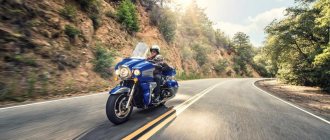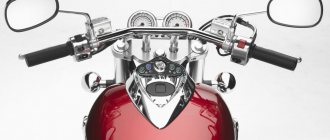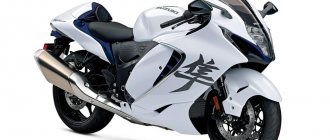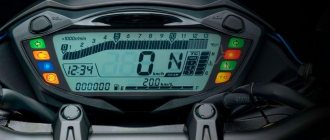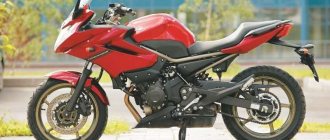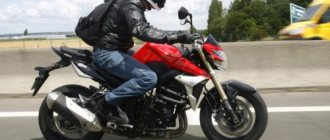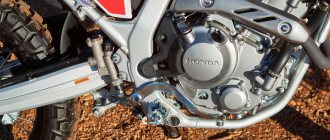Review of the Kawasaki VN 1700 Vulcan motorcycle
Yes, yes... It's time to report on the first thousand in the Cowboy's saddle. This is how Bahero stands for in Spanish - horse shepherd, and this is the main task of cowboys. For other markets it is called Voyager Custom. Unlike the usual one thousand seven hundredth Voyager, the Custom version is distinguished by the absence of a central trunk, wind protection for the legs, a trimmed passenger seat, a short window, a different design of the side trunks and a matte black paint job on the engine. There is an opinion that a regular Voyager also has passenger platforms, but this is not entirely obvious to me.
This is how Bahero stands for in Spanish - horse shepherd, and this is the main task of cowboys. For other markets it is called Voyager Custom. Unlike the usual one thousand seven hundredth Voyager, the Custom version is distinguished by the absence of a central trunk, wind protection for the legs, a trimmed passenger seat, a short window, a different design of the side trunks and a matte black paint job on the engine. There is an opinion that a regular Voyager also has passenger platforms, but this is not entirely obvious to me.
Right off the bat, the base offers electronic throttle with speed-controlled cruise. Previously an option, but now already included in the database, ABS is included. And his tidy is rich. In addition to the standard speedometer-tachometer, there is a fuel gauge, temperature gauge and a large LCD screen with a large amount of necessary and not so necessary information. Including a gear indicator on it. The turn signals are equipped with an auto-off relay for tilting.
Just like on a touring HD, the database already has music with two speakers. Connecting flash drives is not provided, but can be connected via an optional Ipod/Iphone cable.
The Japanese wanted to copy the HD so much that even the behavior of the motorcycle was copied completely. Unfortunately, I personally have not ridden the Road Glide, but I have driven more than four thousand in its twin brother, the Street Glide. I am amazed at their similarity and think that this can be considered a family trait of all cruise tourists. The bike is very neutral. None of the qualities stick out in him. The engine runs smoothly and has the same uniform thrust right from 1,500 rpm (84 hp, 136 Nm).
Unlike the 1800 Sword, in which between 1500 and 2500 rpm the engine reacts extremely nervously to the throttle and shakes in the frame. The six-speed gearbox works clearly and smoothly, but again, compared to the Honda, I still want to add a little more of this same “clarity”. More reminiscent of HD than the Japanese. The belt forgives jerks when shifting down and does not try to skid the wheel. But forgive me - isn’t it for the feeling of power and brutality that large-volume cruisers are bought? In this regard, 1800 SWORD gives an order of magnitude more adrenaline. All its driving qualities are more pronounced. And here is the bland evenness of a tourist. Good and verified, but without zest. I had exactly the same feelings after Street Glide. Even, smooth, sterile. It’s good that the sound is from the V2 and not from the vacuum cleaner.
It’s true that the Japanese didn’t copy everything regarding the Street Glide, but still made a number of improvements to the design. Firstly, it seemed to me that although the Cava’s center of gravity is high, it is still not as high as on Harley. There, if the moto began to tilt in place, there was no way to hold it. You can keep kava. And secondly, Kava’s wind protection was adjusted.
The seating position on the Kava is vertical, the steering wheel is close enough to make maneuvering comfortable. I don’t like this position - I would prefer it with a forward lean. With my height of 173 cm, the wind flow from a small glass comes clearly from the nose and above. But at the same time it does not cause any discomfort. Even an open helmet stands level in the traffic, without hesitation or swaying of the head. As the speed increases, the strength of the flow increases, but this does not cause discomfort. True, by the third hundred of a day's run, the pressure and whistle of the helmet begin to strain. For long-range shots I want to install medium glass.
The seat for the passenger (as in fact on the Street Glide) is quite uncomfortable: narrow where it should be wide and wide where it should be narrow. The shock absorbers have two adjustments. Moreover, the stiffness adjustment was done in exactly the same way as on Harley.
The motorcycle steers well and predictably. The high center of gravity allows you to shift the motorcycle easily and naturally. The SWORD required more effort. True, my SWORD was far from stock :). You can rush between cars as easily and naturally as in sports.
The bike also drives quite confidently in a traffic jam. The belt forgives the release of gas and there is no such need to press the clutch, which, by the way, is adjustable. The dimensions of the motorcycle are within reason, so I didn’t experience any particular problems from riding in the aisles. You sit higher on it than on the SWORD - again, I would prefer to sit as low as possible. The high seating position makes it difficult to roll the motorcycle back.
Sixth gear is super. Stick in the overdrive, turn on cruise and go. 3 thousand revolutions is about 140 km/h. In this mode, a 20 liter tank should be enough for 300-350 km. True, it would be worth checking the promises of the flight computer and comparing it with the liter consumption on receipts. About the brakes, I can only say that I have a version without ABS. As for the rest, it’s too early to say because the stock Bridge is complete crap... We need to let it get used to it. In the meantime, the spendthrift is just trying to block the wheels. True, nothing criminal happens and he continues to move smoothly.
Stick in the overdrive, turn on cruise and go. 3 thousand revolutions is about 140 km/h. In this mode, a 20 liter tank should be enough for 300-350 km. True, it would be worth checking the promises of the flight computer and comparing it with the liter consumption on receipts. About the brakes, I can only say that I have a version without ABS. As for the rest, it’s too early to say because the stock Bridge is complete crap... We need to let it get used to it. In the meantime, the spendthrift is just trying to block the wheels. True, nothing criminal happens and he continues to move smoothly.
The trunks are quite roomy. The manufacturer states that their total capacity is about 76 liters. I don’t know what the volume of panniers is on Rodad/Street Glide, but standard Harley bags fit clearly. Apparently even the trunks are the same in volume.
True, their design does not seem very practical to me personally. They close on the side and it is unlikely to be possible to fill the case to capacity. In this case, the lid will not fit tightly and water may get into the case. We need to get out in the rain and check. There is another problem with the panniers. On the new Gold F6B, the panniers are the same in appearance. The inside also seems to be similar in volume. But Golda Honda claims a capacity of 22 liters. And Kava - 38 liters. Go figure out who to believe. In any case, a 3/4 helmet does not fit in the case.
Already in the base the motorcycle is equipped with two sets of arches. It is very convenient to place a motorcycle on them and carry out work. The HD base does not have rear arches and the bottom of the panniers suffers when tilted.
In my case, the motorcycle had an oil leak. I was already thinking about the vaunted Kawasaki “quality” and was ready for the labor-intensive replacement of the secondary shaft oil seal. But everything turned out to be more prosaic: apparently the belt was caught either by a stone or by a piece of iron. And this unknown thing scratched the cover of the gearbox foot locking mechanism, which is located immediately under the pulley. Apparently it was scratched a long time ago and an unknown American tried unsuccessfully to cover this scratch. Apparently, this is why he quickly sold the car with such scanty mileage. This unfortunate cover is located on the left, so when the moto is standing on the stand, oil oozes through the scratch and does not allow the surface to be properly degreased. I put protective covers made of penofol on the arcs, laid it on the right side, degreased, cleaned, degreased again and applied two-component glue. It took an hour to polymerize using a hairdryer. Well, there have been no oil leaks for a week now. Let's see where anything else will come out.
I was already thinking about the vaunted Kawasaki “quality” and was ready for the labor-intensive replacement of the secondary shaft oil seal. But everything turned out to be more prosaic: apparently the belt was caught either by a stone or by a piece of iron. And this unknown thing scratched the cover of the gearbox foot locking mechanism, which is located immediately under the pulley. Apparently it was scratched a long time ago and an unknown American tried unsuccessfully to cover this scratch. Apparently, this is why he quickly sold the car with such scanty mileage. This unfortunate cover is located on the left, so when the moto is standing on the stand, oil oozes through the scratch and does not allow the surface to be properly degreased. I put protective covers made of penofol on the arcs, laid it on the right side, degreased, cleaned, degreased again and applied two-component glue. It took an hour to polymerize using a hairdryer. Well, there have been no oil leaks for a week now. Let's see where anything else will come out.
So far I like the bike. I initially understood that I wouldn’t find anything better than the SWORD and in any case I would have to sacrifice characteristics. In the meantime, I’m getting used to not paying attention to sports and driving calmly. It's no joke - I lost the start of a car at a traffic light. True, it was an M5, but still. Why did I take it? Yes, out of despair. There is nothing else to choose. But I see decent potential for tuning in this motorcycle.
The Kawasaki 1700 is a very crude motor, this is no longer the same series of cool iron 1500-1600s, this is a motor from scratch! I bought it new in a box, and it began: in order to screw in the spark plugs, you have to remove the tank! The gears are like those of a Harley - tight, loudly clanging ,short - now the 7th is missing, control by wire gives dullness at the start - the Lada has overtaken!, no sound! just hissing! Because of the Euro 4, there is more plastic, the panniers are liquid and tiny inside, but apparently big! the weight is much heavier - 385 kg, the seating position is much higher + the saddle is wide, with a height of 176 only in the Cossacks I could reach the asphalt! and a lot of other bad things...
I already skated half a season on this one, just a nomad, I was disappointed and sold it cheaper! I bought boulevard109, now again vn1600 nomad - it’s cooler in many ways! here is everything I wanted: volume + dynamics, cardan, water supply, hydraulics, huge panniers, stylish look, minimum plastic, correct sound, ease of maintenance. and on auto-ru, like me, I saw that many people were selling 1700s now, having driven 1-1.5 thousand in total! They realized that it was bullshit!
Brief history of the model
2009 - start of production and sales of the Kawasaki VN 1700 Vulcan model series. Model: Kawasaki Vulcan 1700 Classic; Kawasaki Vulcan 1700 Classic Tourer (Nomad); Kawasaki Vulcan 1700 Classic LT; Kawasaki Vulcan 1700 Voyager / ABS (North America, Europe, Australia). Factory designation: VN1700E9F; VN1700C9F; VN1700G9F; VN1700A9F, VN1700B9F (ABS).
2010 - no significant changes. Model: Kawasaki Vulcan 1700 Classic / ABS; Kawasaki Vulcan 1700 Classic Tourer ABS (Nomad); Kawasaki Vulcan 1700 Classic LT; Kawasaki Vulcan 1700 Voyager / ABS (North America, Europe, Australia). Factory designation: VN1700FAF, VN1700EAF; VN1700DAF, VN1700CAF; VN1700GAF; VN1700AAF, VN1700BAF (ABS).
2011 - appearance of the Kawasaki VN1700 Vulcan Vaquero modification. The Classic LT modification is no longer offered. Model: Kawasaki Vulcan 1700 Classic / ABS; Kawasaki Vulcan 1700 Classic Tourer ABS (Nomad); Kawasaki Vulcan 1700 Voyager / ABS; Kawasaki Vulcan 1700 Vaquero (Voyager Custom) / ABS (North America, Europe, Australia). Factory designation: VN1700FBF, VN1700EBF; VN1700DBF, VN1700CBF; VN1700ABF, VN1700BBF (ABS); VN1700JBF, VN1700KBF.
2012 - no significant changes. Model: Kawasaki Vulcan 1700 Classic / ABS; Kawasaki Vulcan 1700 Classic Tourer ABS (Nomad); Kawasaki Vulcan 1700 Voyager / ABS; Kawasaki Vulcan 1700 Vaquero (Voyager Custom) / ABS (North America, Europe, Australia). Factory designation: VN1700FCF, VN1700ECF; VN1700DCF, VN1700CCF; VN1700ACF, VN1700BCF (ABS); VN1700JCF, VN1700KCF.
2013 - no significant changes. Model: Kawasaki Vulcan 1700 Classic / ABS; Kawasaki Vulcan 1700 Classic Tourer ABS (Nomad); Kawasaki Vulcan 1700 Voyager / ABS; Kawasaki Vulcan 1700 Vaquero (Voyager Custom) / ABS (North America, Europe, Australia). Factory designation: VN1700FDF, VN1700EDF; VN1700DDF, VN1700CDF; VN1700ADF, VN1700BDF (ABS); VN1700JDF, VN1700KDF.
2014 - no significant changes. Model: Kawasaki Vulcan 1700 Classic ABS; Kawasaki Vulcan 1700 Classic Tourer ABS (Nomad ABS); Kawasaki Vulcan 1700 Voyager / ABS; Kawasaki Vulcan 1700 Vaquero ABS (Voyager Custom ABS) (North America, Europe, Australia). Factory designation: VN1700FEF; VN1700DEF; VN1700AEF, VN1700BEF (ABS); VN1700KEF.
2015 - Classic modification is no longer offered. Model: Kawasaki Vulcan 1700 Classic Tourer ABS (Nomad ABS); Kawasaki Vulcan 1700 Voyager ABS; Kawasaki Vulcan 1700 Vaquero ABS (Voyager Custom ABS) (North America, Europe, Australia). Factory designation: VN1700DFF; VN1700BEF; VN1700KFF.
2016 - no significant changes. Last year of production and sales in Europe. Model: Kawasaki Vulcan 1700 Classic Tourer ABS (Nomad ABS); Kawasaki Vulcan 1700 Voyager ABS; Kawasaki Vulcan 1700 Vaquero ABS (Voyager Custom ABS) (North America, Europe, Australia). Factory designation: VN1700DGF; VN1700BGF; VN1700KGF.
2017 - The Classic Tourer (Nomad) modification is no longer offered. Model: Kawasaki Vulcan 1700 Voyager ABS; Kawasaki Vulcan 1700 Vaquero ABS (Voyager Custom ABS) (North America, Australia). Factory designation: VN1700BHF; VN1700KHF.
2018 - no significant changes. Model: Kawasaki Vulcan 1700 Voyager ABS; Kawasaki Vulcan 1700 Vaquero ABS (Voyager Custom ABS) (North America, Australia). Factory designation: VN1700BJF; VN1700KJF.
2019 - no significant changes. Model: Kawasaki Vulcan 1700 Voyager ABS; Kawasaki Vulcan 1700 Vaquero ABS (Voyager Custom ABS) (North America). Factory designation: VN1700BKF; VN1700KKF.
2020 - no significant changes. Model: Kawasaki Vulcan 1700 Voyager ABS; Kawasaki Vulcan 1700 Vaquero ABS (Voyager Custom ABS) (North America). Factory designation: VN1700BLF; VN1700KLF.
2021 - no significant changes. Model: Kawasaki Vulcan 1700 Voyager ABS; Kawasaki Vulcan 1700 Vaquero ABS (Voyager Custom ABS) (North America). Factory designation: VN1700BMFNN; VN1700KMFAL.
Chassis
Judging by the weight of almost 400 kg, the manufacturer abandoned the idea of making it light and instead made it strong. The duplex steel tubular frame with square profile main beam has obvious advantages over the aluminum frame. The wheels are 16 inches in size, the steering angle is 30 degrees, and the trail is 178 mm, which with a wheelbase of 167 mm gives excellent stability on straight lines even in crosswinds, and therefore the motorcycle resists slightly in turns, but for this class of technology this is completely natural. The total length of the bike is just over 2.5 meters, but long does not always mean tall, and the 72 cm high seat is proof of this: it will be comfortable for a rider of almost any height.
The front suspension has 14 cm of travel, and the rear gas shock absorbers give 7.8 cm of travel - you can't call it a lot of travel. However, thanks to the ability to pump gas, the rear suspension has a very soft ride, and with four stages of rebound adjustment, it is suitable for different loads and different conditions. Two four-piston front calipers and a two-piston rear caliper are mounted on 300mm discs, both equipped with a proprietary ABS system called Kawasaki Advanced Coactive-braking Technology K-ACT II.
